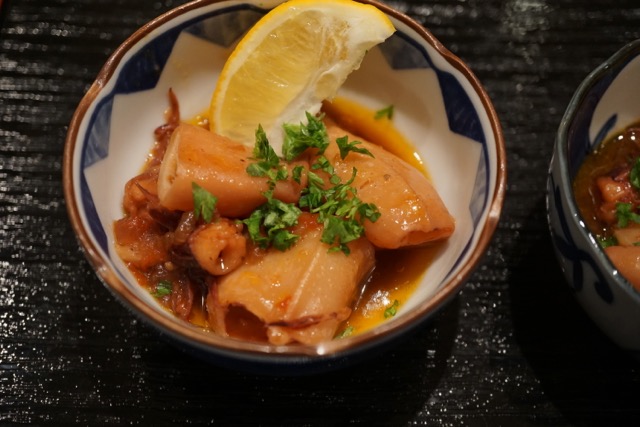
For a while, we used English cucumbers, which were much better than the American variety. Several years ago, however, we switched to "mini-cucumbers" when they started appearing in our grocery stores. Although, not as good as Japanese cucumbers, they are the closest thing we can have to the taste and texture of a Japanese cucumber. They come 5 to 6 in a package and it is not easy to use them up before they go bad. So making cucumber salad or pickles is a good means of inventory control. As a result, I am always looking for new pickle recipes. I saw this recipe and decided to try it.
This is called "Kyuri-no Kyu-chan" きゅうりのキューちゃん and appears to reproduce a popular commercial product of the same name. I have not tasted or seen the commercial product. It is described on the company's website as first being salt pickled, then washed and soaked to remove excess salt, finally, marinated in a secret marinade (of a special soy sauce mix) with ginger. According to the website, all the processes are temperature controlled (i.e. chilled). Interestingly, all homemade recipes I found use hot (temperature) marinade. In any case, this is the result.
This is after 2 days of marination. The cucumber pieces have gotten darker in color.
The below is the first day after it was made.
Ingredients:
Cucumbers, 6 American mini-cucumbers (see picture below), washed, cut into half inch thick rounds.
Kosher salt
For marinade
Soy sauce 80 ml
Concentrated noodle sauce 20ml
Sugar 1 tbs
Rice vinegar 2-3 tbs
Mirin 2tbs
Ginger, thin julienne, 1tsp
Japanese togarashi red pepper 唐辛子, whole, cut into thin rings, seed removed
Directions:
1. Salt the rounds of cucumber and let them sit for 30 minutes. Wash and pat dry.
2. Place the marinade ingredients in a pan and bring to a boil. Cut the flame and add the cucumber (see below).
3. Let it sit until cooled to room temperature.
4. Remove the cucumber and set aside. Turn on the fire and let the marinade come to a boil.
5. Repeat 2, and 3 three times.
6. Add the ginger and red pepper in the last marinading step.
7. Let it cool to room temperature then place it in a sealable container.
Initially, the marinade appeared too small for the amount of cucumber but the liquid coming out of the cucumber made the marinade more than enough. According to the recipe, the tastes gets better amalgamated after 2 days in the refrigerator.
Although we have never tasted the commercial variety, we really liked this pickled cucumber. It still had a nice crunchiness. The taste was sweet, sour and salty with hints of heat and ginger making this a pickle with a complexity of flavor. We had this as is for a drinking snack but I am sure this will go well with rice.

























